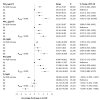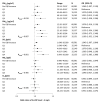Long-Term Effects of Ambient Particulate and Gaseous Pollutants on Serum High-Sensitivity C-Reactive Protein Levels: A Cross-Sectional Study Using KoGES-HEXA Data
- PMID: 36141854
- PMCID: PMC9517608
- DOI: 10.3390/ijerph191811585
Long-Term Effects of Ambient Particulate and Gaseous Pollutants on Serum High-Sensitivity C-Reactive Protein Levels: A Cross-Sectional Study Using KoGES-HEXA Data
Abstract
Ambient air pollutants reportedly increase inflammatory responses associated with multiple chronic diseases. We investigated the effects of long-term exposure to ambient air pollution on high-sensitivity C-reactive protein (hs-CRP) using data from 60,581 participants enrolled in the Korean Genome and Epidemiology Study-Health Examinees Study between 2012 and 2017. Community Multiscale Air Quality System with surface data assimilation was used to estimate the participants' exposure to criteria air pollutants based on geocoded residential addresses. Long-term exposure was defined as the 2-year moving average concentrations of PM10, PM2.5, SO2, NO2, and O3. Multivariable linear and logistic regression models were utilized to estimate the percent changes in hs-CRP and odds ratios of systemic low-grade inflammation (hs-CRP > 3 mg/L) per interquartile range increment in air pollutants. We identified positive associations between hs-CRP and PM10 (% changes: 3.75 [95% CI 2.68, 4.82]), PM2.5 (3.68, [2.57, 4.81]), SO2 (1.79, [1.10, 2.48]), and NO2 (3.31, [2.12, 4.52]), while negative association was demonstrated for O3 (-3.81, [-4.96, -2.65]). Elevated risks of low-grade inflammation were associated with PM10 (odds ratio: 1.07 [95% CI 1.01, 1.13]), PM2.5 (1.08 [1.02, 1.14]), and SO2 (1.05 [1.01, 1.08]). The odds ratios reported indicated that the exposures might be risk factors for inflammatory conditions; however, they did not reflect strong associations. Our findings suggest that exposure to air pollutants may play a role in the inflammation process.
Keywords: ambient air pollution; cross-sectional study; gaseous pollutant; high-sensitivity C-reactive protein; long-term exposure; particulate matter; systemic low-grade inflammation.
Conflict of interest statement
The authors declare no conflict of interest.
Figures



Similar articles
-
C-reactive protein (CRP) and long-term air pollution with a focus on ultrafine particles.Int J Hyg Environ Health. 2018 Apr;221(3):510-518. doi: 10.1016/j.ijheh.2018.01.016. Epub 2018 Jan 31. Int J Hyg Environ Health. 2018. PMID: 29428699
-
Short-term exposure to air pollution on peripheral white blood cells and inflammation biomarkers: a cross-sectional study on rural residents.BMC Public Health. 2024 Jun 26;24(1):1702. doi: 10.1186/s12889-024-19116-2. BMC Public Health. 2024. PMID: 38926692 Free PMC article.
-
Air pollution is linked to cognitive decline independent of hypersensitive C-reactive protein: insights from middle-aged and older Chinese.Environ Health. 2024 Dec 20;23(1):111. doi: 10.1186/s12940-024-01148-1. Environ Health. 2024. PMID: 39707297 Free PMC article.
-
Associations between ambient air pollutants and blood pressure among children and adolescents: A systemic review and meta-analysis.Sci Total Environ. 2021 Sep 1;785:147279. doi: 10.1016/j.scitotenv.2021.147279. Epub 2021 Apr 23. Sci Total Environ. 2021. PMID: 33940406
-
Short-term exposure to particulate matter (PM10 and PM2.5), nitrogen dioxide (NO2), and ozone (O3) and all-cause and cause-specific mortality: Systematic review and meta-analysis.Environ Int. 2020 Sep;142:105876. doi: 10.1016/j.envint.2020.105876. Epub 2020 Jun 23. Environ Int. 2020. PMID: 32590284
Cited by
-
Air Pollution and Lung Cancer: Contributions of Extracellular Vesicles as Pathogenic Mechanisms and Clinical Utility.Curr Environ Health Rep. 2023 Dec;10(4):478-489. doi: 10.1007/s40572-023-00421-8. Epub 2023 Dec 6. Curr Environ Health Rep. 2023. PMID: 38052753 Free PMC article. Review.
-
Association between short-term exposure to ambient air pollutants and biomarkers indicative of inflammation and oxidative stress: a cross-sectional study using KoGES-HEXA data.Environ Health Prev Med. 2024;29:17. doi: 10.1265/ehpm.23-00199. Environ Health Prev Med. 2024. PMID: 38494707 Free PMC article.
-
The relationship between air pollutants and preterm birth and blood routine changes in typical river valley city.BMC Public Health. 2024 Jun 24;24(1):1677. doi: 10.1186/s12889-024-19140-2. BMC Public Health. 2024. PMID: 38915004 Free PMC article.
-
Association of sarcopenia, ambient air pollution and cognitive function in a community-dwelling middle-aged and elderly Korean population: a community-based cohort study.BMJ Open. 2024 Dec 5;14(12):e092448. doi: 10.1136/bmjopen-2024-092448. BMJ Open. 2024. PMID: 39638595 Free PMC article.
-
Association between air pollutants and initiation of biological therapy in patients with ankylosing spondylitis: a nationwide, population-based, nested case-control study.Arthritis Res Ther. 2023 May 5;25(1):75. doi: 10.1186/s13075-023-03060-4. Arthritis Res Ther. 2023. PMID: 37147678 Free PMC article.
References
-
- World Health Organization Ambient Air Pollution: A global Assessment of Exposure and Burden of Disease. 2016. [(accessed on 20 February 2022)]. Available online: https://apps.who.int/iris/handle/10665/250141.
-
- Cohen A.J., Brauer M., Burnett R., Anderson H.R., Frostad J., Estep K., Balakrishnan K., Brunekreef B., Dandona L., Dandona R. Estimates and 25-year trends of the global burden of disease attributable to ambient air pollution: An analysis of data from the Global Burden of Diseases Study 2015. Lancet. 2017;389:1907–1918. doi: 10.1016/S0140-6736(17)30505-6. - DOI - PMC - PubMed
-
- Stanaway J.D., Afshin A., Gakidou E., Lim S.S., Abate D., Abate K.H., Abbafati C., Abbasi N., Abbastabar H., Abd Allah F. Global, regional, and national comparative risk assessment of 84 behavioural, environmental and occupational, and metabolic risks or clusters of risks for 195 countries and territories, 1990–2017: A systematic analysis for the Global Burden of Disease Study 2017. Lancet. 2018;392:1923–1994. doi: 10.1016/S0140-6736(18)32225-6. - DOI - PMC - PubMed
-
- Burnett R., Chen H., Szyszkowicz M., Fann N., Hubbell B., Pope C.A., Apte J.S., Brauer M., Cohen A., Weichenthal S. Global estimates of mortality associated with long-term exposure to outdoor fine particulate matter. Proc. Natl. Acad. Sci. USA. 2018;115:9592–9597. doi: 10.1073/pnas.1803222115. - DOI - PMC - PubMed
Publication types
MeSH terms
Substances
LinkOut - more resources
Full Text Sources
Medical
Research Materials
Miscellaneous

